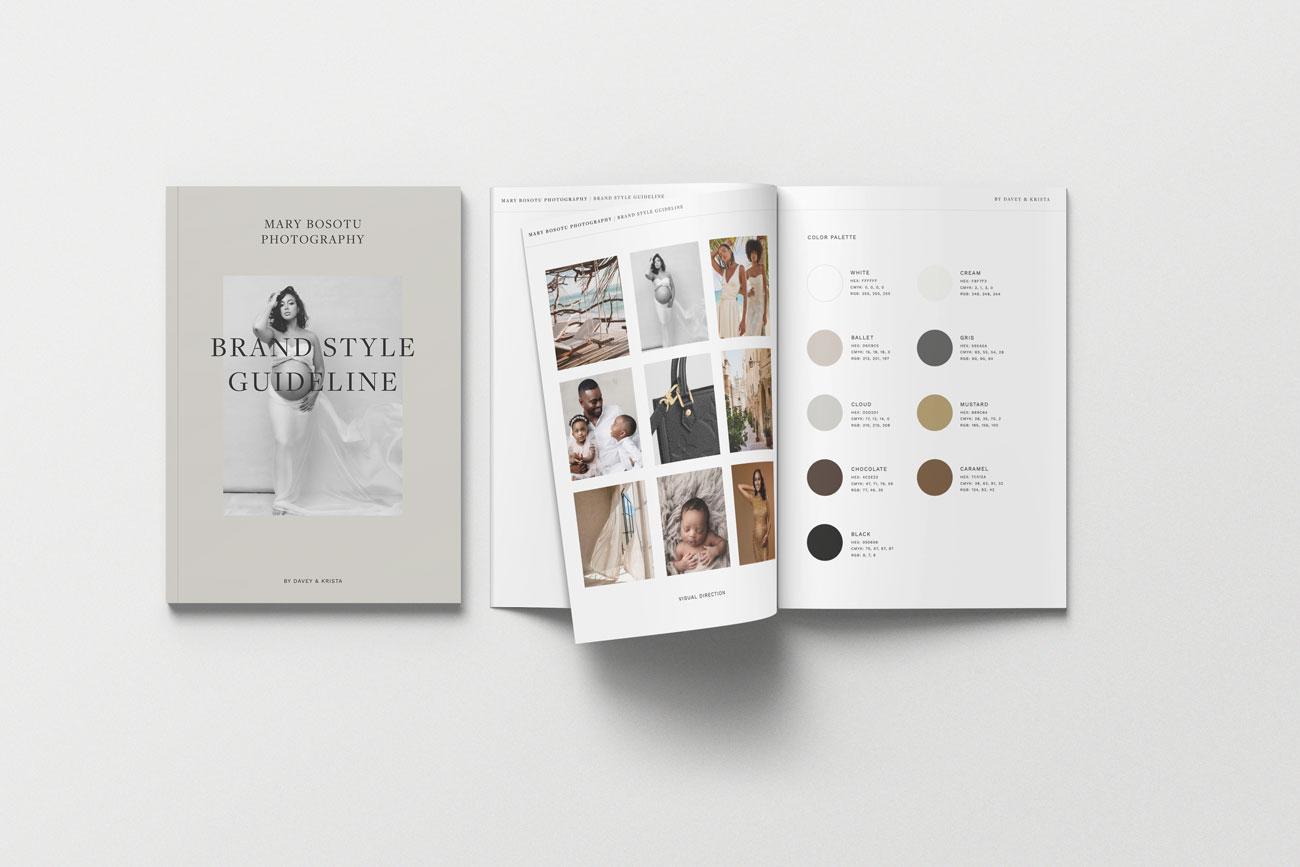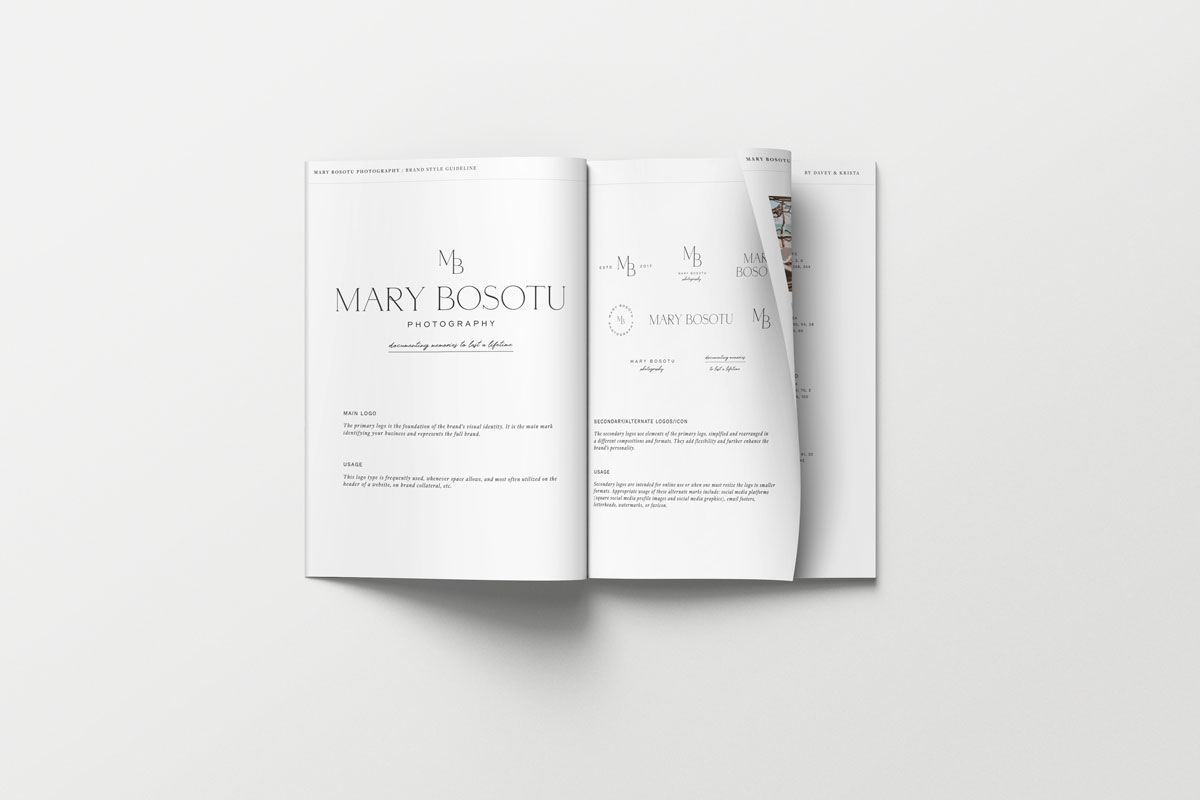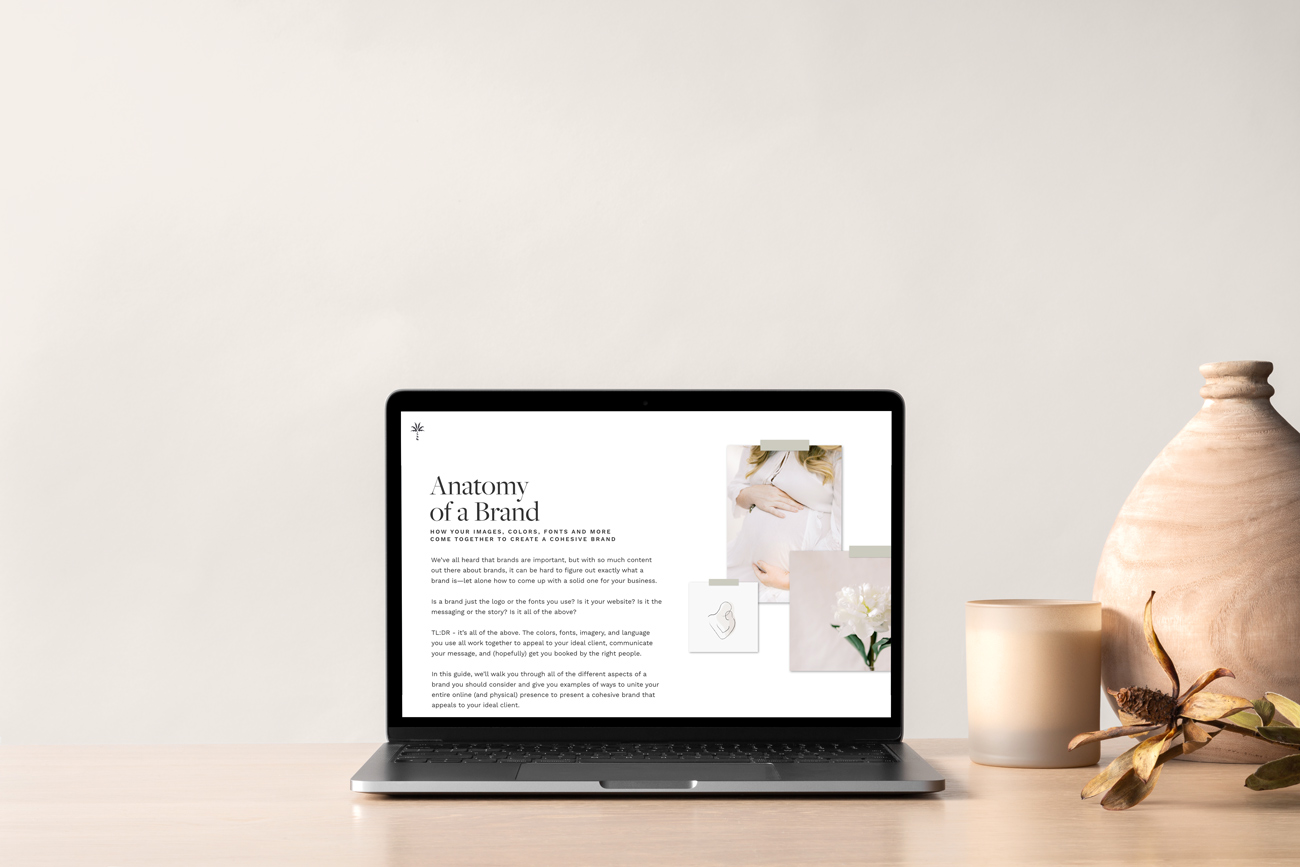
Podcast show notes and resources can be found at the bottom of this post.
What are brand guidelines?
Here’s how to create brand guidelines…
Brand design.
Everyone knows it’s important—especially for creative businesses where aesthetics matter. But why is it so important? And how do you make sure your brand is implemented across your business.
Enter: Brand Guidelines.
This post is going to outline the importance of brand guidelines: What they are, why they’re important, what should be included in your brand guidelines, and how you can develop guidelines for your brand.
Table of Contents
Understanding brand guidelines
What is a brand?
We find it helpfup to think of a brand as the unique identity behind a company or product. As a consumer, you hopefully recognize it right away, and you have a sense of 1) what you’re getting from the company or product, and 2) what sets it apart from others in the industry.
There’s a lot about a brand that comes down to visuals. A logo is part of a brand’s identity, as is the recognizable font it uses on its website, collateral, and other properties. Without even thinking about it, you could probably recognize the Nike “swoosh,” the Starbucks siren, or even the distinctive font used for the titles of the Harry Potter books.
But branding goes beyond just logos and fonts. A brand will also encompass the style of all imagery associated with a company or product. Some brands will be light and airy, whereas others will be dark and moody. They will likely use a specific color palette, whether it’s monochrome shades of gray or something a little more vibrant.
Finally, there are elements beyond the visual. The specific voice used in all the copy on a website and in marketing material is part of a brand identity—and it’s just as important as the visuals. Word choice, expressions, and tone will help convey whether a brand is sophisticated, laidback, elegant, or humorous.
All these elements work together to elevate a business in a client or customer’s eye. Branding creates consistency, which makes a brand more recognizable and, in some cases, more memorable and more trustworthy. You feel as if you’re part of a community by embracing certain brands (a la Swifties), and you know you can depend on the product or service you’re buying.
And that’s brand design is so important.
Introducing brand guidelines
With all of that being said, you as a business-owner might be thinking, “Okay, but how do I figure out what my brand is?” Your brand isn’t something that accidentally happens to you—it’s something you consciously and strategically create yourself. And the best way to ensure you’re covering all aspects you need (not to mention staying consistent across all platforms) is by actually determining your brand guidelines, a written set of standards for everything related to your brand.
Every business should have a set of brand guidelines, as these standards will make it easy for everyone involved to be on the same page (if you’ll pardon the pun). Your web designer can use it to build your website and update it on a regular basis. A graphic designer can use it when laying out print material or designing company swag. Your social media manager can use it when creating content for your Facebook page. With brand guidelines, nobody is left trying to make their own best guess.
Why do brand guidelines matter?
When you think about your favorite brands and why you like them so much, it’s easy to appreciate branding from a client or customer’s perspective. Now it’s time to appreciate it from your perspective as a business-owner. By developing a well-thought-out brand, you are providing the same recognizability, reliability, and sense of community for your own customers.
Brand guidelines help you maintain the uniformity you need if you’re going to achieve this. Developing a set of guidelines will require you to think through all aspects of your brand: Why am I choosing these colors? What phrases would my brand use if it were actually talking? Nothing gets overlooked.
Once your brand guidelines are developed, you’ll likely see how much more streamlined and efficient your design and marketing efforts become. You no longer have your designers and team members asking questions, second-guessing choices, or trying to make judgement calls.

When will you use your brand guide?
There are all kinds of places where your brand guide will come in handy. The most obvious place will be your website, but beyond that, there’s other digital and print collateral where you’ll want to maintain the same consistent aesthetic and vibe.
On the digital front, you can use your brand guide to create email templates or the cover for eBooks and podcasts. Analogue elements where it will be important could be your business cards, pamphlets, signage, apparel, and welcome kits.
Finally, there’s social media. When you’re creating graphics to share or writing copy to post, your brand guides make it so your entire team has an easy time collaborating on a pretty all-consuming effort.
How to Create Your Own Brand Style Guide
You probably already have a clear vision in your head of what your brand is—so how are you actually supposed to communicate all of that into a guide? It’s overwhelming. You don’t even know where to start.
Here’s the thing: Creating a brand style guide is actually a lot easier than you think it is. It’s just a matter of going through each element one by one.
Elements of a Brand Style Guide
To create a thorough and effective brand guide, be sure to include details on each of the following:
- Logo: Less is more in this case. Strive for something that’s simple but recognizable.
- Sub-Logo: Not all brands have just one logo. Have a secondary one that you can use where your primary one isn’t practical or appropriate. Your sub-logo should have a similar style, while also being simple and recognizable. Strive for coordinating logos that are easy to vary or adapt.
- Brand Colors: Choose colors that align with specific emotions or that will appeal to a specific demographic that is your target audience. This is another element where less is more—you want no more than two main colors and no more than three secondary colors.
- Fonts: Like colors, fonts suggest specific emotions or personalities. Don’t use an elegant font if your brand is supposed to feel laidback and casual. Focus on one primary font you can use for headlines and other eye-catching text, and no more than two secondary fonts that are easier to read at a smaller size for body text.
- Brand Voice: Determine what kind of person your brand will sound like. Young? Old? Fun loving? Posh? Humorous? Determine what expressions, phrases, or slang you frequently use, and whether there’s any language that’s off limits.
- Packaging and Shipping: If you have a product that you package and ship, your brand extends to the way you box everything up. Do you print your logo and brand on the shipping material, or do you use simple brown paper? Is it easy to see what’s inside, or will your customer be focused more on the packaging itself? Remember that packaging could be one of the final impressions you make on your customer or client, so make it distinctive.

How to Create Brand Guidelines for Your Business
Ready to get started? Great! There’s no one right way to assemble a brand guide, but there are best practices that have proven effective for others before you. Here are some valuable tips to keep in mind:
- Keep it simple. Even if you have a strong vision for your brand identity down to every last detail, you could end up creating a guide that’s too restrictive if you make it complicated. This is especially true if you’re not working with a brand designer, who can advise you as to what brand aspects you need to consider and which ones you don’t need to worry about.
- Stay consistent. It’s easy to get excited about all the possibilities, but remember that the whole point of a brand guide is to ensure consistency across all platforms and media. There’s no sense in deciding that you like one shade of red for anything digital and another shade of red for anything printed. Choose a single shade of red and stick to it.
- Remember that there needs to be congruency between your visual brand and your brand voice. If your visuals all feel very sophisticated, a conversational brand voice may not make sense. On the other hand, if your brand copy is very straightforward and direct, it won’t fit well with ostentatious (hello SAT words) visuals. Your visuals and voice should reflect the same kind of personality.
- If you have the budget, why not work with a brand designer? A brand designer can help you make savvy choices that will resonate with your target audience. (In fact, did you know we offer semi-custom brand suites, which give you an affordable starting point for creating a brand that’s a good fit for you?)
- Specify situations where you might use a secondary logo instead of your primary logo, particularly when it comes to sizing. You should also consider alternates in situations where your brand fonts are not available—this can frequently be a problem with web platforms that don’t allow use of custom fonts, such as Canva or Flodesk.

DOWNLOAD – Anatomy of a Brand
Well, we covered a lot of ground there, but you’ll probably agree the message is clear: Brand design is important, and brand style guidelines are necessary if you want to brand properly.
Want to take the next step? Our free guide, The Anatomy of a Brand, walks you through the step-by-step process of creating your brand, so you don’t need to second-guess any of the decisions you’re making while you set yourself up to be booked by the right people.
Don’t forget about our semi-custom brand suites—a great fit for many businesses that want all the bells-and-whistles of a custom brand without the custom price tag.
Or if you’re really serious about developing a unique brand that fits you perfectly, consider working with us for a full custom brand design, including your logo, website, marketing collateral, and everything in between. Check out what it includes here!









VIEW THE COMMENTS
Add A Comment